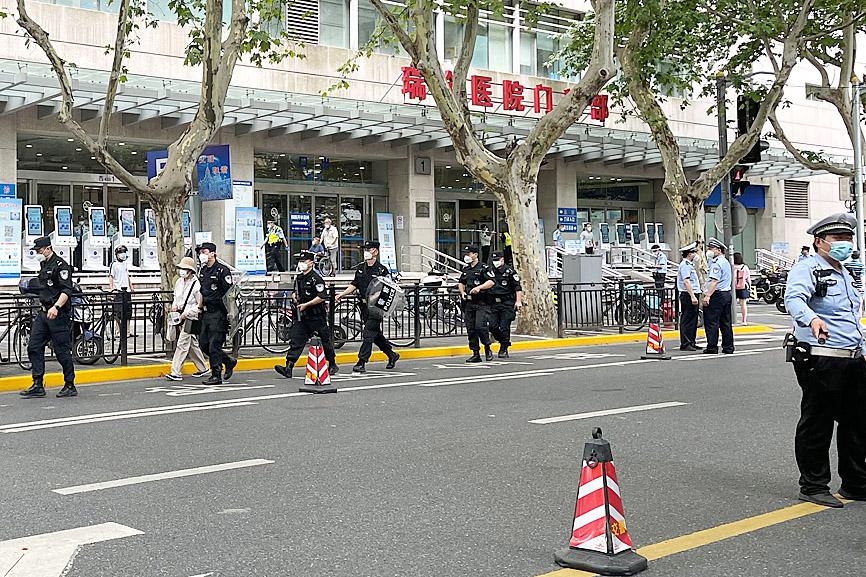Four people were yesterday morning wounded in a stabbing at a major Shanghai hospital, before the knife-wielding attacker was shot and subdued by officers, local police said.
Huangpu District police said on social media that they received emergency reports at 11:30am of a stabbing at downtown Ruijin Hospital.
“The police quickly arrived on the scene and discovered a man holding a group of people hostage with a knife on the hospital’s seventh floor” of the outpatient department, the statement said. “When the suspect intended to injure the hostages and punish the police, the police decisively fired a shot to injure and subdue him.”

Photo: Reuters
Four members of the public were being treated for wounds and are “not in a life-threatening condition,” the statement added.
The attacker’s motive remains unclear and the incident is being investigated, police said.
Video footage on social media showed chaos as visitors clambered under turnstiles to get out of the hospital, while doctors were seen running out with their patients, some in wheelchairs and one on a mobile bed.
A long trail of blood was seen on the marble surface of a flight of stairs in one video.
“It’s very shocking,” said a Shanghai resident who had arrived for a checkup just after the hospital was sealed off, declining to give her name. “This is very despairing. What has happened to this society?”
Hospitals are a flashpoint for many in China, who face issues from touts illegally trading appointment tickets, long queues to see doctors and corruption that can push up the cost of receiving care.
Reports of patients assaulting doctors are also common.
Mass violent crime is rare in China, which strictly prohibits citizens from owning firearms, but knife attacks do happen occasionally.
A man was on Monday arrested after going on a stabbing spree in the city’s downtown Jingan District.
Last month, a 23-year-old man in the eastern city of Ningbo died after being violently stabbed on the street in broad daylight.
Video of the attack near a bus stop went viral on social media.

It is usually a serene two-and-a-half-hour ride on Japan’s famously efficient bullet train, but on Saturday, the journey quickly descended into a zombie apocalypse, with passengers screaming in terror. Organizers of the adrenaline-filled trip, less than two weeks before Halloween, touted it as the world’s first haunted house experience on a running Shinkansen. On board one chartered car of the Shinkansen, about 40 thrill-seekers were ready to brave an encounter with the living dead between Tokyo and the western metropolis of Osaka. The eerie experience was inspired by the hit 2016 South Korean action-horror movie Train to Busan, in which a father and

IRANIAN THREATS: Revolutionary Guards chief Hossein Salami said that it would be a ‘mistake’ for Israel to attack Iran and if it did ‘we will strike you again painfully’ Israel yesterday bombed a Syrian coastal city, while the US conducted multiple strikes on targets in Yemen nearly a month into Israel’s war with Hezbollah in Lebanon. Syria, the Houthi rebels in Yemen, Hezbollah and Hamas in Gaza all belong to the so-called “axis of resistance” led by Iran, which on Oct. 1 conducted a missile strike on Israel. Israel has vowed to retaliate for the strike. Iran’s Revolutionary Guards chief Hossein Salami yesterday said in a speech that Tehran would hit Israel “painfully” if it attacks Iranian targets. “If you make a mistake and attack our targets, whether in the region or in

NEW RECRUITS: A video released by Ukrainian officials allegedly shows dozens of North Koreans lining up to collect military fatigues from Russian servicemen Russian aerial strikes wounded more than a dozen and knocked out electricity for tens of thousands of Ukrainians overnight in attacks on residential areas as temperatures dropped toward freezing, Kyiv said yesterday. Ukraine also said it had targeted a crucial Russian explosives factory, about 750km from the border, in an overnight drone attack, while Moscow said it had shot down 110 drones, the largest attempted aerial barrage by Kyiv in more than two weeks. At least 17 people were wounded in an attack on Kryvyi Rig, Ukraine, including a first responder, the Ukrainian State Emergency Service said. “At night, the enemy attacked Kryvyi

The space rock that slammed into Earth 66 million years ago at the end of the Cretaceous Period caused a global calamity that doomed the dinosaurs and many other life forms, but that was far from the largest meteorite to strike our planet. One up to 200 times bigger landed 3.26 billion years ago, triggering worldwide destruction at an even greater scale, but as new research shows, that disaster actually might have been beneficial for the early evolution of life by serving as “a giant fertilizer bomb” for the bacteria and other single-celled organisms called archaea that held dominion at the